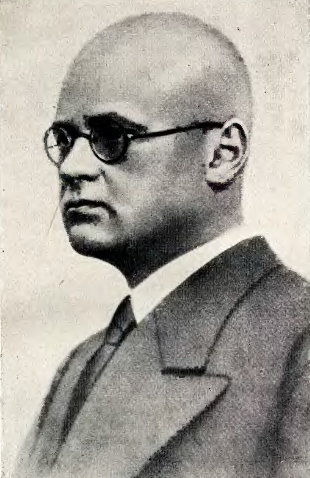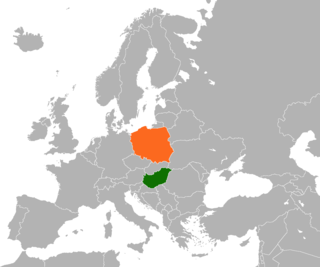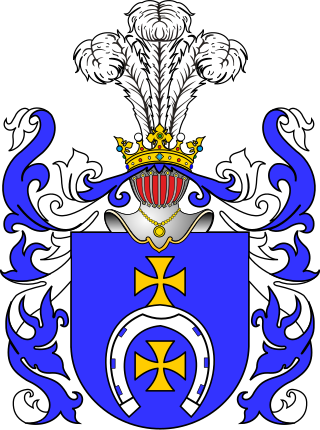| Total population | |
|---|---|
| 93 (2010) [1] | |
| Regions with significant populations | |
| Metro Manila | |
| Languages | |
| Spanish · Philippine languages · Polish | |
| Religion | |
| Roman Catholic | |
| Related ethnic groups | |
| Polish people, Polish diaspora, German settlement in the Philippines |
Polish settlement in the Philippines began during the Spanish colonial period, mostly with the arrival of Catholic clergy destined for missionary work in other Asian countries. As of 2010 [update] the 2010 census, there are 93 persons in the Philippines who claim Polish citizenship, and the Polish community in the Philippines is the fourth-largest Central European community in the country, after the local communities of Germans, Hungarians and Albanians. [1]
Although there is evidence that Polish settlement in the Philippines began during the Spanish period, and while there certainly was interaction between the two countries, any history of the Polish community in the Philippines prior to the end of the 19th century is virtually unknown. [2] As early as 1618 though, Poles were already recorded as being among the nationalities seen in old Manila. [3]
It is believed that the first documented case of a Pole setting foot into the Philippines was that of Wojciech Męciński, a Jesuit missionary from Kraków who participated in missionary activities in Japan, China and Vietnam. In 1642, Męciński arrived in Manila from Vietnam along with a large group of fellow Jesuits, where they were greeted by Governor-General Sebastián Hurtado de Corcuera. Męciński stayed in Manila for a few months before he was deployed on his second visit to Japan, where he was martyred in Nagasaki on March 23, 1643. [2]
The second Pole to arrive in the Philippines was another Jesuit missionary, Jan Chryzostom Bąkowski from Częstochowa. Bąkowski initially participated in missionary activities in China, particularly in Jiangsu. However, he was arrested and sent to Canton, where after being unable to deal with being kept in forced isolation, he departed for Manila. While in Manila, he participated in evangelizing among the Chinese Filipino community until his death in 1731. Aside from Bąkowski, several Polish Catholic clergy have also stayed in the Philippines, including Władysław Michał Zaleski, who served as papal delegate to the East Indies from 1886 to 1916, and Józef Wiśniewski, who served as a missionary in the Philippines prior to becoming a chaplain in the Polish Army, where he was arrested by the Germans in 1940 and died at the Dachau concentration camp. [2]
It is believed that the first non-religious Pole to arrive in the Philippines was Maksymilian Teofil Gumplowicz from Kraków, who between 1883 and 1886 served as a doctor for the Dutch navy in the Dutch East Indies (modern-day Indonesia). During his tour of duty with the Dutch navy, Gumplowicz visited not only islands throughout the Dutch East Indies, but also the Philippines, British Malaya and New Guinea. [2]
The American colonial period saw rapid growth in the local Polish community, although most people in the Philippines at the time who were of Polish descent were Polish Americans. One of them, Michael Sendzimir, a second lieutenant in the 98th Infantry Division during World War II, was the eldest son of industrialist Tadeusz Sendzimir. [2] However, prominent Poles from Poland proper also visited the Philippines during this time, including pianist Artur Rubenstein, who gave a concert in Manila in 1935, geologist Józef Zwierzycki, whose findings on the tectonics of northern New Guinea was published in the Philippine Journal of Science in 1926, and sculptor Michał Paszyn, who arrived in the Philippines in 1933 and eventually married a Filipina before moving to Italy. [2] In the interbellum, there was one Polish-ran enterprise, Sielski Sweet Shop Co. in Manila, a sweet shop and caramel and chocolate factory established by Polish immigrant Władysław Sielski. [4] [5] Sielski founded a Polish library in Manila. [5] He sympathized with Filipino independence aspirations and photo-documented their efforts. [5]
Today some Poles come to the Philippines as immigrants, expats, foreign exchange students or settled down to the Philippines by their Filipino spouses.

The Polish diaspora comprises Poles and people of Polish heritage or origin who live outside Poland. The Polish diaspora is also known in modern Polish as Polonia, the name for Poland in Latin and many Romance languages.

Gryf, also known as Jaxa, is a Polish coat of arms that was used by many noble families in medieval Poland and later under the Polish–Lithuanian Commonwealth, branches of the original medieval Gryfita-Świebodzic family as well as families connected with the Clan by adoption at ennoblement or even by error.

Poraj is a Polish Coat of Arms. Used by several knighthood families of medieval Poland and noble families of the Polish–Lithuanian Commonwealth - those descended in the male-line from the Poraj family and those allowed into the heraldic clan by adoption.

Michał Rola-Żymierski was a Polish high-ranking Communist Party leader, communist military commander and NKVD secret agent. He was appointed as Marshal of Poland, and served in this position from 1945 until his death.
Władysław Czapliński was a Polish historian, a professor of the University of Wrocław, author of many popular books about Polish history.

"Pole and Hungarian brothers be" and "Pole and Hungarian, two good friends" are English translations of a proverbial saying about the traditional brotherhood and camaraderie between Poles and Hungarians.

Józef Feldman was a Polish historian of Jewish ethnicity, professor of the Jagiellonian University in Kraków and a member of the Polish Academy of Learning.

Denmark–Poland relations refers to the bilateral relations between Denmark and Poland. Relations between the two countries date back to the Middle Ages, while modern diplomatic relations were established on 8 September 1919. During the 20th century, relations were turbulent but amicable. The two countries moreover maintained a maritime border dispute until 2018 when it was delineated.

Poland–Hungary relations are the foreign relations between Poland and Hungary. Relations between the two nations date back to the Middle Ages. The two Central European people have traditionally enjoyed a very close friendship, brotherhood and camaraderie rooted in a deep history of shared rulers, cultures, struggles, and faith. Both countries commemorate their fraternal relationship on 23 March.

Jan Mikołaj Smogulecki (1610–1656), of the Grzymała coat of arms, was a Polish nobleman, politician, missionary, scholar and Jesuit credited with introducing logarithms to China.

There is a long history of Poles in Azerbaijan. Although the current Polish population of the Republic of Azerbaijan is lower than in former times, the number of people with Polish descent in the capital city Baku is around 2,000 and several thousand self-identified Poles live in Azerbaijan. Poles as an ethnic group have lived in Azerbaijan for centuries. The Russian Empire included Azerbaijan and parts of Poland, thus it could deport members of opposition of Polish nationality there, which explains the presence of Poles in Azerbaijan.

Philippines–Poland relations are the bilateral relations between the Philippines and Poland. Formal diplomatic relations between the two countries were established on September 22, 1973, but contact between the two peoples dates back to the seventeenth century.
Polish people in Lebanon may refer to people born in or residing in Lebanon of full or partial Polish origin. They are a small group in Lebanon. Almost all of which live in Beirut.

Aleksander Sielski (1610–1682) was a Polish noble. He bore the Lubicz coat of arms, as the envoy to the king, was the Castellan of Gniezno and Łęczyca, Chamberlain of Poznań and 74th Marshal of Sejm in the Polish–Lithuanian Commonwealth (1652).

Japan–Poland relations refers to the bilateral foreign relations between Japan and Poland. Both nations enjoy historically friendly relations, embracing close cooperation and mutual assistance in times of need. Both are members of the OECD, World Trade Organization and United Nations.

The Embassy of Poland in Manila is the diplomatic mission of the Republic of Poland to the Republic of the Philippines. The embassy was opened on January 4, 2018, although a previous embassy was also established in the early 1990s.

During the Holocaust in Poland, 1939–1945, German occupation authorities engaged in repressive measures against non-Jewish Polish citizens who helped Jews persecuted by Nazi Germany.
Wojciech Męciński, nicknamed Alberto Polacco was a Polish Catholic Jesuit missionary from Kraków, widely believed to be the first Pole to visit south-eastern Asia.

Poles in China form a small population, estimated at 1,000 and mostly concentrated in the major cities of Beijing, Guangzhou, Hong Kong and Shanghai. First noted Polish people lived in China in the 17th century.
{{cite book}}: CS1 maint: location missing publisher (link)